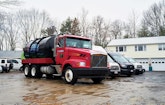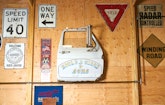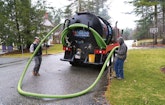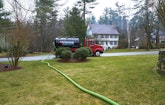
The crew at Timothy A. Giard & Son Plumbing & Heating includes, from left, Jeremy Giard, Timothy Giard, Tim Hunt, Allyson Giard, Paul Dubois, Chris Eyssi and Dale Brien.
For years, people calling Timothy A. Giard & Son Plumbing & Heating for septic pumping were referred to other local contractors. That practice ended with the purchase of a used vacuum truck in August 2018, signaling a new direction for the 35-year-old, family-owned company based in North Andover, Massachusetts.
The upshot? A new revenue stream and a way to tap potential new customers for the company’s plumbing and hydronic heating services, says Jeremy Giard, 27, the company’s vice president and co-owner with his father, Timothy Giard.
Missing out on pumping revenue always bothered the younger Giard. He already was somewhat familiar with the industry, having worked occasionally for a relative who operates a septic service company formerly owned by Giard’s grandfather, Emile.
“It always was in the back of my mind — something I always wanted to do,” Giard explains. “My dad and I have been spitballing the idea for the last few years. And other competitors in the area are getting older.
“So I figured this is a good time to offer this service to our clients,” he continues. “We already have a foot in the door with our hydronic and general plumbing services, and people ask periodically if we know anyone who pumps out tanks. Instead of referring them to other companies, I said I’d find an inexpensive truck and start doing it ourselves.”
Giard’s interest intersected with opportunity when he saw a used vacuum truck for sale in the Pumper Trader classified ads: a 1989 Volvo Aero equipped with a 4,000-gallon tank. For Giard and his father, it was a now-or-never moment, he recalls.
“So I drove up to Maine to take a look at the truck and fell in love with it,” he says. “And that’s how we got started. But I’m not in this to take out anybody or ruffle any feathers. I just saw a need that will emerge in the near future and figured rather than let someone else take it, why not me?”
Easy access to a treatment plant, located just 3 miles away, made the proposition even more attractive. “I can put the truck in neutral and pretty much coast there,” he jokes.
SOLID POTENTIAL
The vast majority of local towns in the company’s service area (North Andover is about 30 miles north of Boston) primarily employ septic systems to handle waste, so there’s no lack of potential customers. To gain customers, the company relies on word-of-mouth referrals, as well as direct mail flyers and social media platforms such as Facebook and Instagram, he says.
On the other hand, Giard says he’s not interested in generating an explosive influx of customers, which would make it more difficult to provide good customer service and to continue tending to plumbing customers. “We’re in this for the long game, not exponential growth,” he explains.
Giard spends an average of two days a week pumping septic tanks with a driver the company hired specifically to handle pumping. The duo pumps out anywhere from four to six tanks a day, he says.
“We’ll soon get to a point where our driver will do it full time and take it from there,” he notes. “Right now he’s the only one with a commercial driver’s license, so he drives and we both do the pumping.”
What would Giard tell other plumbers who might consider diversifying into septic pumping? Do the marketing groundwork, and then be patient since building a new business from scratch takes time, even under the most favorable of circumstances.
“You’re going to get some bumps and bruises along the way,” he says. “But if growing a business like this is your goal, you’ve got to stick with it. At times, your truck might break down and the phone might not ring as much as you want it to. But all you can do is get your name out there and tell people why they should use you.”
KEY TO LONGEVITY
Timothy Giard established the company in 1985 in a tiny office in his parents’ home. The business primarily centered on residential plumbing and repair along with installing hot-water boilers for hydronic heating systems — plus the occasional remodeling project thrown in the mix.
Providing both plumbing and heating services proved to be a good business mix with plenty of opportunities for cross marketing. Jeremy Giard estimates the company’s current revenue breakdown on the plumbing side is about 50-50 between heating and plumbing.
How does a company stay in business for 35 years? Being honest with customers, which leads to a lot of referrals, he says.
“My dad taught me to give customers as much information about their problem as possible, then present them with options and let them make a decision,” Giard notes. “We’re not going to try and pull a fast one and sell customers something they don’t need.”
Giard also credits the company’s middle-of-the-road position in the market in terms of pricing — not the cheapest outfit around, but not the most expensive either. And a little luck didn’t hurt.
“We always were small enough to sneak past any [economic] recessions,” he adds. “We offered multiple services and never had more than 10 employees. Our guys always have something to do. … We’ve never laid anyone off in 35 years.”
EQUIPPED TO SUCCEED
The company’s only vacuum truck is the 1989 Volvo, updated with a 3,600-gallon steel tank fabricated by New England Mechanical Overlay and a vacuum pump from National Vacuum Equipment. It made sense for the company to buy a used truck for a new business venture. By avoiding a large monthly payment on a truck loan, the company is under less pressure to build business faster than desired, Giard points out.
“It’s not costing us anything if it sits for, say, a week,” he says. “By not overextending ourselves financially, we’re in a better position to succeed.”
For plumbing services, the company relies on five service vehicles: a 2015 and 2016 Ford Transit 250, 2015 Ford Transit 350 and 2015 Ford Transit Connect. The company left the drain cleaning arena several years ago, but it still owns a Milwaukee Tool drain snake and an AIRSNAKE for unclogging smaller drainlines.
The company also owns a RIDGID SeeSnake standard camera and a Milwaukee Tool infrared thermal imager, used to detect leaks inside walls, floors and ceilings. Technicians generally prefer Milwaukee Tool power tools.
SUSTAINABLE GROWTH
Pumping septic tanks currently accounts for about 20% of the company’s business volume. Giard would like to see that rise to 30% or even 40% in the years ahead. Ideally, he envisions adding another vacuum truck within five years to have enough capacity to handle any additional customers the company might pick up as other area pumpers retire.
In the meantime, Giard says he plans to keep learning as much as possible about the pumping industry and keep a sharp focus on providing optimal customer service, just the way his father has for decades with plumbing and heating clients.
“My dad still treats every client as if it’s his first one,” Giard says. “I’m convinced that’s why he’s been so successful for 35 years. He still grinds out every day like it’s his first day in business. And my goal is to keep doing that.”











